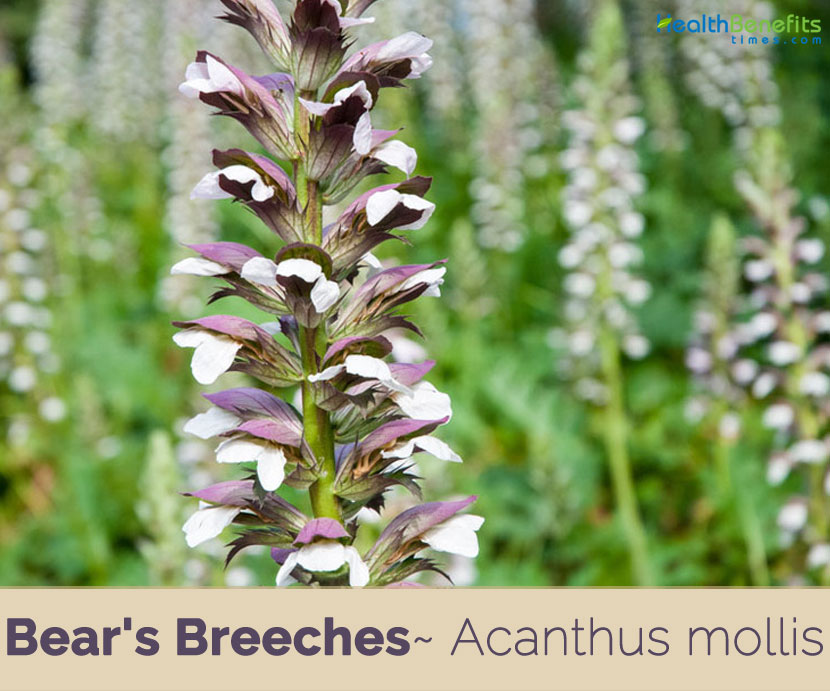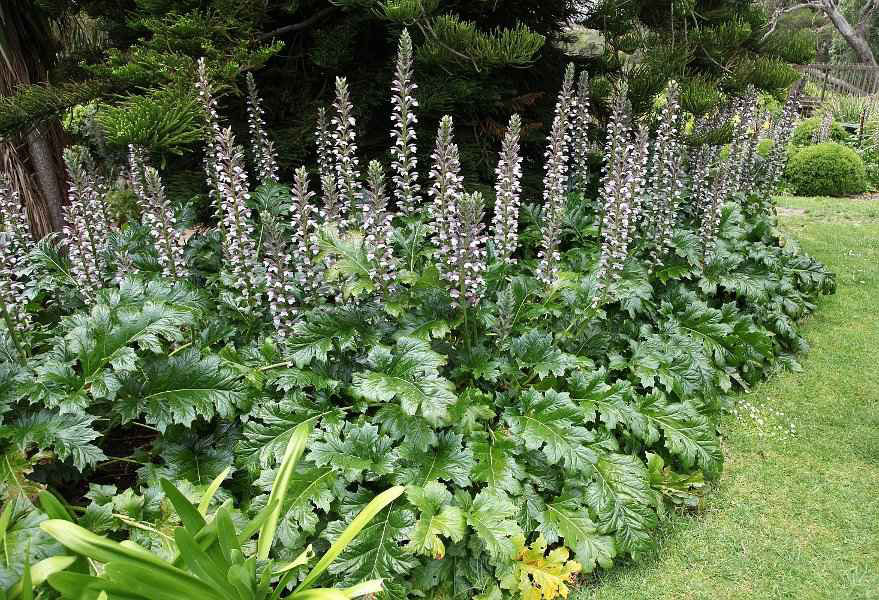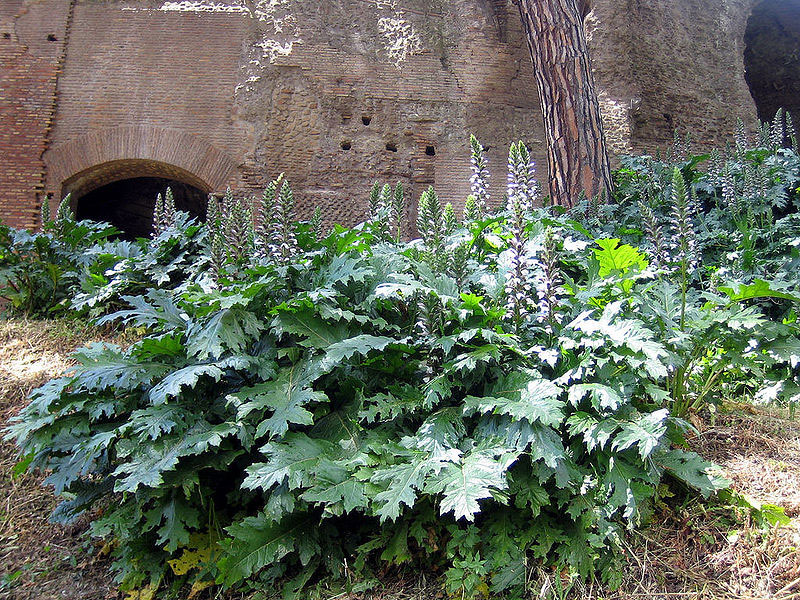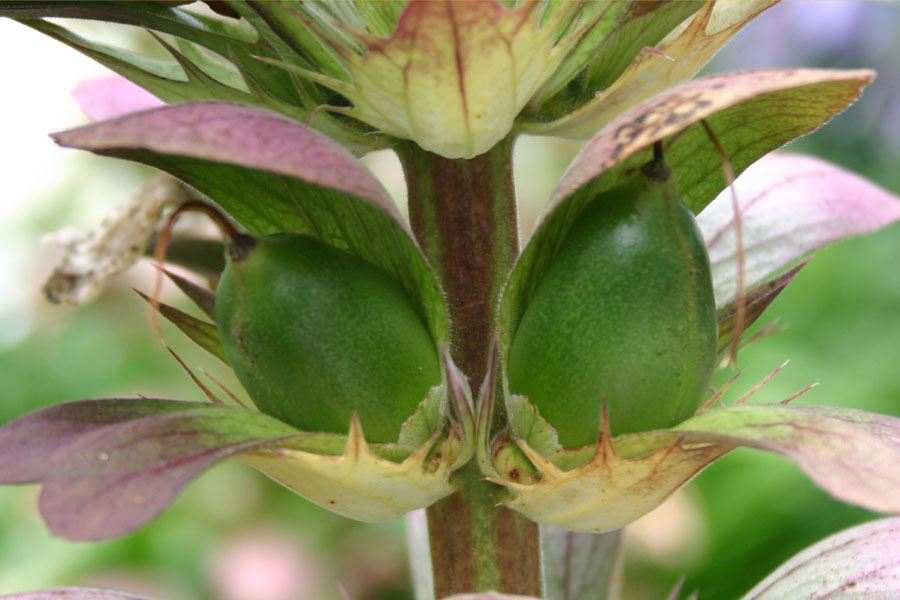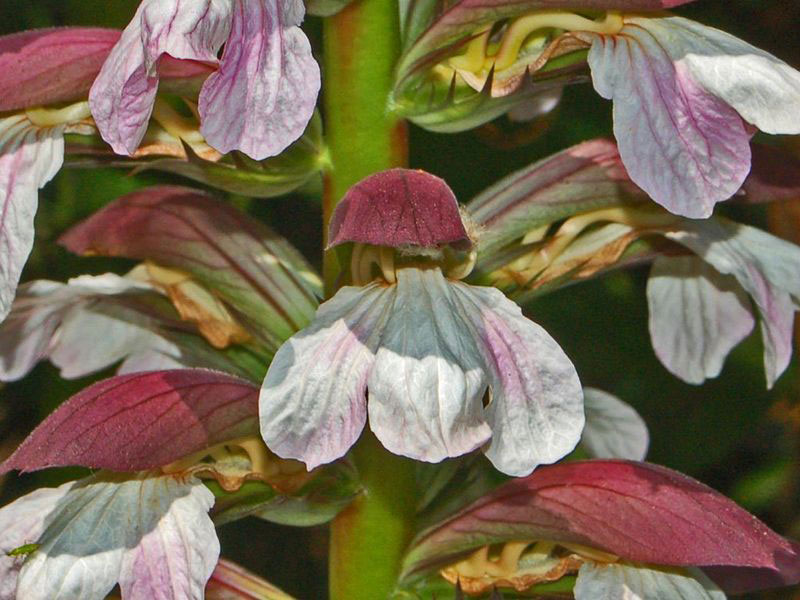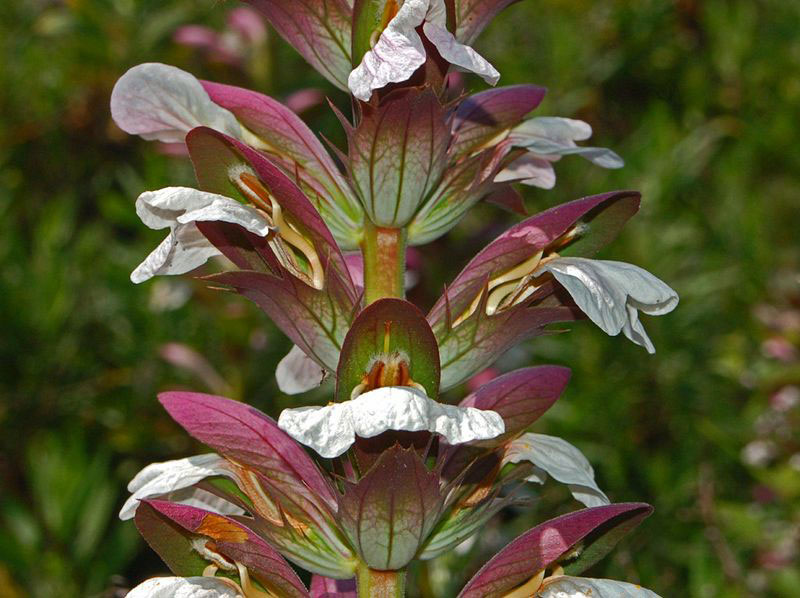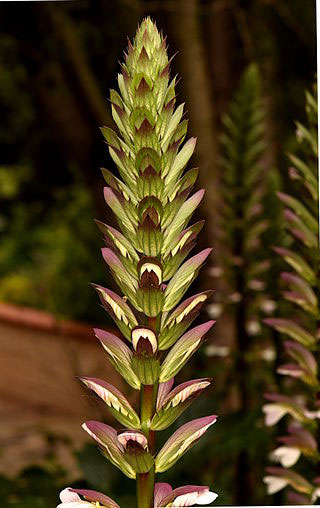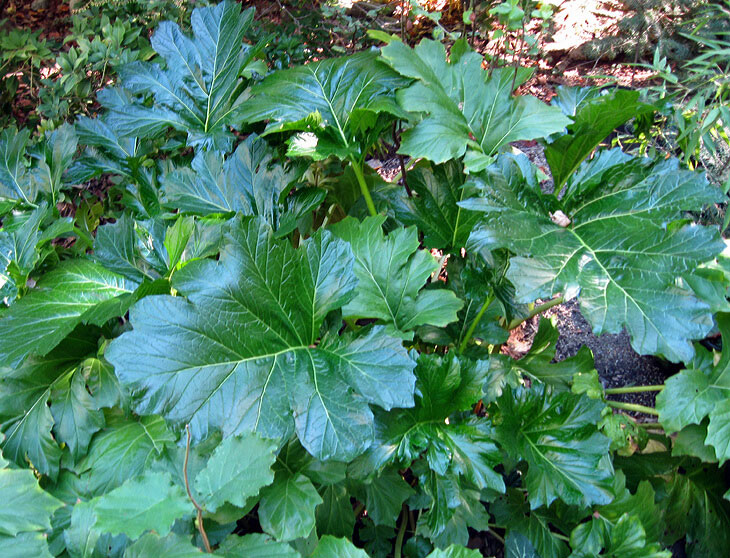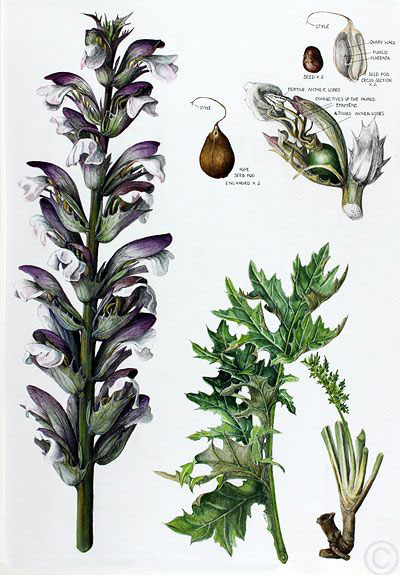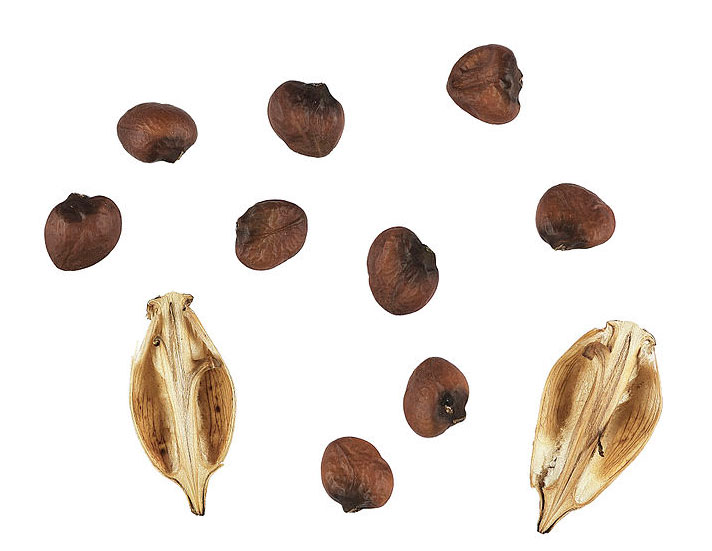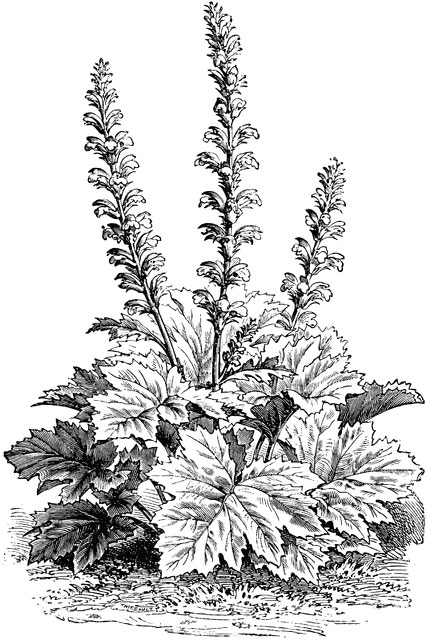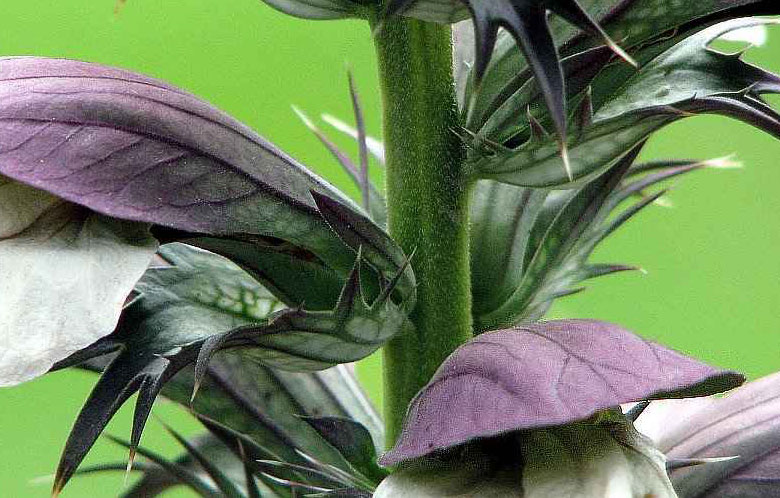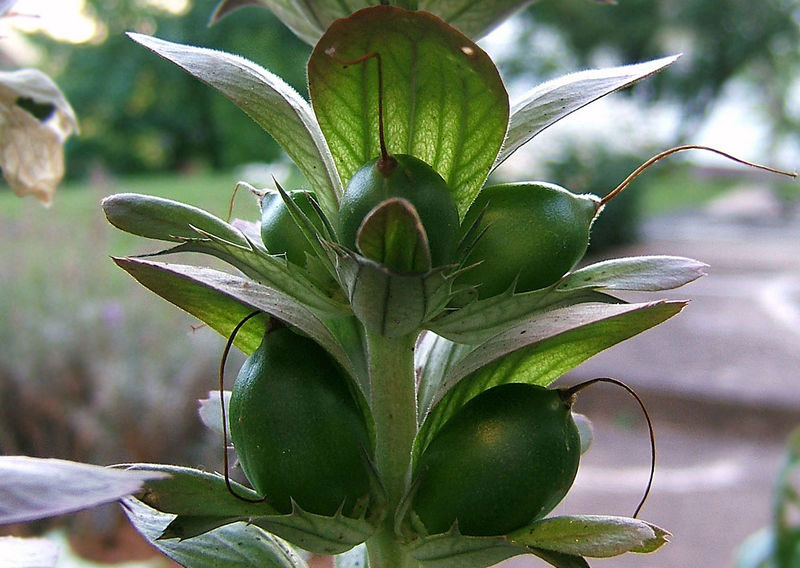The name of the genus derives from the Greek name of the plant ἄκανθος ákanthos; it was imitated in Corinthian capitals. This ἄκανθος ákanthos is related to ἄκανθα ákantha meaning “thorn” referring to the thorn-bearing sepals, or any thorny or prickly plant in Greek. The Latin name of the species, mollis meaning “soft, smooth”, refers to the texture of the leaves. Acanthus leaves have a classical appearance and were the source of the Corinthian leaf motif developed and used as a decoration in ancient Greek and Roman art and architecture. It is believed that the leaves of A. mollis or A. spinosis were the model for the sculptured leaves that adorn the capitals of the Corinthian columns that became popular in the 4th century B.C.
Plant Description
Bear’s Breeches are a clump-forming, rhizomatous, perennial herb that grows up to 30–80 cm (12–31 in) of height, with a maximum of 180 cm (71 in). The plant is found growing in woodland scrub, stony hillsides, waste land, roadsides, railway banks, coastal areas, disturbed areas, forests, riparian zones, scrublands and urban areas, coastland and ruderal/disturbed. It can grow in a variety of soil types, including clay, and those that are dry and sandy. It prefers light to medium soil types. Leaves are borne on petioles up to 50 cm long and are about 30 cm long and 50 cm wide, hairless, and with deeply pinnate lobes that are acutely toothed.
Flowers & Fruits
Inflorescence is a cylindrical spike 30–40 cm (12–16 in) long and can produce up to 120 flowers. Flowers are tubular, whitish, and lilac or rose in color. Each flower is up to 5 cm (2.0 in) long and it is surrounded by three green or purplish bracts. The central bract is spiny and larger than the other two. The calyx has two lips: the upper is purple on top, rather long and forms a kind of “helmet” on top of the corolla. The corolla is reduced to a white lower lip, trilobed, with purple-pink venation. The four stamens are fused to the corolla and look like tiny brushes. Flowering normally takes place from June to August. Fertile flowers are followed by an ovoid capsule containing two to four large black seeds.
Varieties of Bear’s Breeches
Acanthus balcanicus var. hungaricus Hungarian Bear’s Breech: The most widely adaptable species, it blooms later and is less susceptible to late frosts.
Acanthus mollis Common Bear’s Breeches: This is the most popular species, but it can also be the most temperamental about blooming, with buds being damaged by late spring frosts.
Acanthus. Spinosus Spiny Bear’s Breeches: This is more adaptable than A. mollis and more thistle-like.
Traditional uses and benefits of Bear’s Breeches
- Leaves and roots are astringent, detergent, emollient and vulnerary.
- The plant consists of considerable quantities of mucilage and tannin.
- Traditionally it was used as a treatment for dislocated joints and for burns.
- Paste made from the plant, when applied to a dislocated joint, tends to normalize the affected muscles and ligaments, concurrently relaxing and tightening them to encourage the joint back into its proper place.
- Crushed leaves have been used as a poultice to soothe burns and scalds.
- For internal use, the plant’s emollient properties are useful in treating irritated mucous membranes within the digestive and urinary tracts.
- Bear’s Breeches has been used as a wound healer and internally taken to soothe the mucous membranes in the digestive and urinary tracts.
- Crushed leaves have been used in poultices and placed on burns or scalds to relieve the pain.
- It is a first- rate remedy for burns, drawing out the fire, and heals it without a scar.
- It has astringent qualities and has been used to treat diarrhea and to heal wounds, as well as being used to clean wounds.
- It has been taken internally to purify the blood and to calm the stomach.
- It is also a valuable remedy in hectic fevers, as it restores radical moisture to the consumptive.
- Indians used the Bear’s Breeches leaves for as anti-venom.
References:
https://www.itis.gov/servlet/SingleRpt/SingleRpt?search_topic=TSN&search_value=506051#null
https://pfaf.org/user/Plant.aspx?LatinName=Acanthus+mollis
http://www.floracatalana.net/acanthus-mollis-l-
https://plants.usda.gov/core/profile?symbol=ACMO8
http://www.iucngisd.org/gisd/species.php?sc=1663
http://issg.org/database/species/ecology.asp?si=1663&fr=1&sts=&lang=EN
https://en.wikipedia.org/wiki/Acanthus_mollis
http://wgb.cimmyt.org/gringlobal/taxonomydetail.aspx?id=100692
http://tn-grin.nat.tn/gringlobal/taxonomydetail.aspx?id=100692
http://www.theplantlist.org/tpl/record/kew-2615276
http://www.flowersofindia.net/catalog/slides/Bear’s%20Breeches.html
https://gd.eppo.int/taxon/ACUMO
https://davesgarden.com/guides/pf/go/177/#b
Comments
| Bear's Breeches Quick Facts | |
|---|---|
| Name: | Bear's Breeches |
| Scientific Name: | Acanthus mollis |
| Origin | Southern Europe, Morocco, Tunisia, Algeria, the Mediterranean islands, Turkey, Syria and the Canary Islands |
| Shapes | An ovoid capsule containing two to four large black seeds |
| Health benefits | Beneficial for dislocated joints, soothe burns and scalds, treat diarrhea and heal wounds |
| Name | Bear’s Breeches |
|---|---|
| Scientific Name | Acanthus mollis |
| Native | Southern Europe, Morocco, Tunisia, Algeria, the Mediterranean islands, Turkey, Syria and the Canary Islands |
| Common Names | Artists’ acanthus, Bear’s breeches, Bearsfoot, Brank-ursin, Greek acanthos, Oak-leaf bear’s-breeches, Oyster plant (Aust.), Sea-dock, Sea-holly, bear’s breech, common acanthus, acanthus, soft-leaved bear’s breeches |
| Name in Other Languages | Arabic: Aqintus (أقنتوس) Aqenetus Catalan: Acant, Cànem de bruixa, Herba carnera, Herba geganta, ala d’àngel, branca ursine, carnera, caruera, orella de tata Chinese: Há ma huā (虾蟆花 ), Lǎo shǔ lè (老 鼠簕) Corsican: Acantu Croatian: Meki primog Czech : Paznehtuik mĕkký Danish: Akantus, Blød akantus Dutch: Acanthus, Breedbladige acanthus, Zachte acanthus English: Artists’ acanthus, Bear’s breeches, Bearsfoot, Brank-ursin, Greek acanthos, Oak-leaf bear’s-breeches, Oyster plant, Sea-dock, Sea-holly, bear’s breech, common acanthus, acanthus, soft-leaved bear’s breeches Finnish: Akantti, Kreikanakantti French: Acanthe, Acanthe à feuilles molles, Acanthe molle , Acanthe sans épines, Acantu, Branc ursine, Branche-ursine, Branc-ursine, Brancursine, Branque-ursine, Patte d’ours, Pied d’ours Gallician: Acanto German: Akanthus, Bärenklau, Bärenklaue, Bärentatzen, Dornenloser Akanthus, Lang und wichblättrige Bärenklau (as var. latifolius), Pracht-Akanthus, Weichblättrige Bärenklau, Weiche Bärenklau, Weiche Schwarz-Bärenklau, Weicher Akanthus, Pracht-Akanthus, echte Bärenklaue Greek: Ákantha Ákanthos (Áκανθα Áκανθος) Hebrew: קוציץ Kotsitz Hindi: Akantusa mōrisa (अकंतुस मोरिस) Hungarian: Akantusz, Hosszú levelű medveköröm, Medveköröm, Medvetalpfű, Nyugati medveköröm Italian: Acanti, Acanto, Acanto comune, Branca orsina, Brancalupo, Brancorsina, Marmoracia Japanese: Akansasu (アカンサス), Akansasu morisu (アカンサス・モリス ), akantsusu (アカンツス), haazami (ハアザミ) Maltese: Hannewija Persian: Gandal (گندل), Kangar (کنگر), Kangar ha (کنگرها) Polish: Akant miękki, akant Portuguese: Acanthus, Acanto, Acanto-grego, Erva-gigante, acanto-dos-poetas, acanto-manso, branca-ursina, gigante, pé-de-urso Russian: Aкант Akant, акант мягкий Serbian: Aкант Akant. Mечја шапа Mečja šapa, Tраторак Tratorak Slovekian: Akant mäkký Spanish: Acanthus, Acanto, Ala de angel, Hierba giganta, Giganta, Acanto, alas de angel, alcanto, branca medicinal, carderona, carneruna, flor de Argel, hierba carderona, hierba gigantina, lampazo, nazarenos, nazarenos de Andalucía, oreja de gigante, oreja gigante, Swedish: Akantus, Björnkloört, Mjukakantus, björnklo, blød akantus Turkish: Kenger otu, Uzun ve yumusak yaprakli ayi pençesi, Yumusak kara ayi pençesi, Yumusak yaprakli ayi pençesi, ayıpençesi |
| Plant Growth Habit | Rhizomatous, perennial herb |
| Growing Climates | Woodland scrub, stony hillsides, waste land, roadsides, railway banks, coastal areas, disturbed areas, forests, riparian zones, scrublands and urban areas, coastland, ruderal/disturbed |
| Soil | Can grow in a variety of soil types, including clay, and those that are dry and sandy. It prefers light to medium soil types |
| Plant Size | Up to 30–80 cm (12–31 in) of height, with a maximum of 180 cm (71 in) |
| Leaf | Leaves are borne on petioles up to 50 cm long and are about 30 cm by 50 cm, hairless, and with deeply pinnate lobes that are acutely toothed |
| Flowering season | June to August |
| Inflorescence | Inflorescence is a cylindrical spike 30–40 cm (12–16 in) long and can produce up to 120 flowers |
| Flower | Tubular, whitish, and lilac or rose in colour. Each flower is up to 5 cm (2.0 in) long and it is surrounded by three green or purplish bracts. The central bract is spiny and larger than the other two. |
| Fruit Shape & Size | An ovoid capsule containing two to four large black seeds |
| Propagation | By seed, division and separation of large tuberous roots. |
| Plant Parts Used | Leaves, root |
| Varieties |
|
| Other Facts |
|


